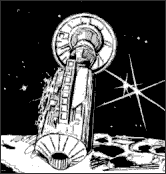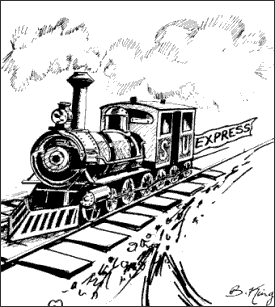| ZX-81 Software Scene |
A NEW COMPANY, Orion, has launched into the ZX software market with a lunar lander program for the 16K ZX-81, Moon Lander.
Lunar lander programs for the ZX-81 are not something which we encounter very often these days. This type of program idea is well-worn and anyone producing another version should be sent into orbit.

At the start you have a chance to select a practice touchdown. More often than not when playing the game you will be informed that there is a new crater on the lunar surface where you have just landed. For that reason a practice routine is a necessity. When in flight, the control panel with all the landing instruments is shown, together with an indicator marking the height at which you are orbiting round the moon.
That update of the display is fast but the program stops every time it requires an input from the keyboard.
It would have been better to use an INKEY-type routine for it. The game would have been made faster and the player would not have to press NEWLINE for every entry.
The instructions are printed on the cassette insert. They lack structure and provide little useful information to the budding astronaut. The language used would be better understood by a NASA trainee than someone who wants to play a game.
Unfortunately there is not much we can say in favour of the game. It is unoriginal, the instructions are largely unintelligible and the screen display is confusing. It is, however, the first Orion product and should be treated as such.
Moon Lander can be obtained from Orion, Surrey.
ORWIN SOFTWARE has released no new software for about six months, so its Cassette Five is a long time overdue. As with all Orwin software, it is for the ZX-81 and most of the six programs run in 16K. All except one of the programs are popular arcade games such as Byteman, a version of Pac-man, and Blitz, a version of City Bomber.
Most of the games are in machine code. The one written in Basic is Merchant and its author is Michael Orwin, who started Orwin Software more than a year ago.
Merchant is a strategy game in which you must visit ports such as Alexandria, Venice and Florence. During your stay in Florence you can visit your old friend the moneylender who appears in many of these types of games. He will give you financial assistance or you can leave your money for him to look after. Both options usually result in the same thing.
The game includes graphics and, although it is not very original in concept, will provide some entertainment as you try to make your first million.
The other games are machine-coded. They need to be, as they are all arcade favourites. The games are unoriginal in concept but the quality of the software and the smooth action displays created on the screen make the programs worthwhile for anyone who has a ZX-81 and plays games using it.
Most of the games include well-presented instructions which make them easier to play. It is pleasant to see that Orwin's kind of quality is available again.
Cassette Five can be obtained from Orwin Software, London. It costs £6.
SINCLAIR RESEARCH has launched two new games, Sabotage and City Patrol, for the 16K ZX-81. Sabotage is a game in which you must take one of two roles, either the guard or the saboteur. If you choose to be the guard you must protect the randomly-placed boxes of ammunition which litter the compound.
If you are the guard, you will have to corner the saboteur before he can plant explosives in a secret place. If you are not quick enough, the explosives will detonate and you will lose some of the boxes of ammunition.
Your score will decrease depending on how many boxes you lose. If you capture the enemy, the points added to your score will, of course, be unaffected by the number of boxes blown-up.
You may want to take the role of the saboteur. In that case the game changes and you must evade the guard, played by the computer, and plant your explosives. Your score depends on how destructive you can be. The program has an original games concept and the action is reasonably smooth. The only problem occurs in the instructions which are printed on the cassette insert card. The game is explained in simple fashion and the movement keys are shown. The difficulty is that Sinclair Research seems to have taken it for granted that the user will know which key moves the figure which way on the screen. The W and S keys move the character up and down respectively and the H and J keys move it left and right.
Sinclair may be correct in thinking that most users will know which keys do what but many users will certainly be beginners who have just become accustomed to the keyboard.
In City Patrol, a city is on the verge of destruction as enemy fighters zoom in and try to raze buildings to the ground. It is your task to take on those invaders and destroy them. At the very least you must prevent them destroying the skyscrapers.
The game produces a 3D view of the city on the screen. There are four levels of the city and you can select which one you want to enter at the start of the game. We rate the game highly, because of its depth of graphics and plot. It is difficult to produce such a smooth 3D effect on the ZX-81.
The instructions are easy to understand but, as with Sabotage, they could be more clearly set out on the cassette insert. We found it difficult to keep track of the instructions because they were cramped into such a small space and, in certain parts, were too verbose. Each instruction insert starts with a story line and if that was abbreviated, more room could be allocated for the playing instructions.
Sabotage and City Patrol are available separately from Sinclair Research, Surrey.
| Spectrum Software Scene |
THE LATEST release from Artic Computing is for the 48K Spectrum and can only be described as excellent in almost every detail. Combat Zone is a version of Tank Battle, a game which can be seen in most amusement arcades. It is a three-dimensional game which has become popular the last few months.
You are the only survivor of a battle fleet of tanks. Your tank roams around a landscape made up of three-dimensional pyramids. You must confront and destroy the enemy tanks and spaceships which attack you.
The display is completely in 3D and although the game is difficult to play at first, strategies can soon be learned and you can become a crack shot.
The author has produced a display format which adheres strictly to that of the type of game you find in arcades. Everything has been finely-tuned to add to the player's enjoyment. You can even specify whether you want to concentrate in total silence.
3D Combat Zone can be obtained from Artic Computing Ltd, North Humberside.
THERE ARE surprisingly few bank account programs for the Spectrum but those which are available are excellent pieces of software.
Bank Account System, for the 48K Spectrum, will store all the details of a bank account, whether they be cash or cheque transactions. It will keep account of the payment of standing orders and also calculate and update the balance.
The system provides full error-trapping and will not allow you to type-in any incorrect answers, although there is an omission at the beginning of the program which could be mistaken for a bug.
When you first use the program you are asked to type-in the present date. When you re-use the system the old date is displayed and you are asked for a new present date. If you enter a date which falls before the old date the program will accept it.
That may serve some historical purpose so far as file-handling is concerned but it could also lead to errors on the system.
The program is well-structured and the user should have no difficulty entering the data required by the computer to do its calculations.
Unlike some other accounting programs which are also written in Basic, the code which stores the password is well hidden in the program lines, although someone who knows a little about the Spectrum could probably by-pass it.
Bank Account System is good value and costs only £3. It is available from K J Gouldstone, Surrey.

SOME microcomputers, including the Dragon and the BBC microcomputer, have a command call Trace which will run through a program displaying it line by line to show the flow of that program.
The Spectrum has no such command in its Basic language but the omission has been remedied by the release of a machine code routine, also called Trace, for both versions of the computer.
The routine lists a user program line by line; when it reaches a GO TO or GO SUB it will jump to the line specified by that instruction.
If Trace finds an error in a program it will inform the user and if an endless loop has been set up in a user program it will be easier to detect.
Unlike the Trace command on some computers, the routine will allow the program to run while it is executing the Trace. The run is performed in the main part of the screen area and it is useful to compare that output to the program line which is creating it at the bottom of the screen.
The routine provides an effective Trace command and is a useful debugging tool. It is easy to use and can be operated with no knowledge of machine code.
Trace can be obtained from Texgate Computers Ltd, Dorset. The package costs £6.95.
IF A COMPANY has produced a compiler for the Spectrum or the ZX-81, the temptation must exist to publish some games which have been produced with the program. Softek has fallen into the trap and produced a range of arcade games, known collectively as Ultima.
One of the cassettes in the range, for the 16K Spectrum, is Firebirds. It is little more than a thinly-disguised version of Phoenix, or Winged Avenger, with two motherships which look like pretzels floating around the screen.
The game is supposed to be set in space but there is no evidence of stars and the screen is black except for the birds, motherships and other moving parts.
Unfortunately the author has not been careful to reduce the effect of colour-clash which occurs when two shapes on different coloured squares seemingly interact.
The effect is worst in the explosion sequences when you can see the outlines of the character squares in which the spaceships were designed originally.
We detected two display bugs on the screen in the second and third phases. Parts of the display disappear during play and no effort seems to have been made to circumvent the difficulty. That at least would be excusable if the effect was not so apparent.
The game could have been reasonably good if more attention had been paid to detail. Perhaps it would be a good idea for Softek to forget about compiler games and produce something in pure machine code. The games may be easy to produce but they are not so much fun to play.
Firebirds can be obtained from Softek, London. It costs £5.95.
See also the correction in Software Scene, November 1983.

TRAX is a Pac-man-type game for the 48K Spectrum. The maze is a railway track and the Pac-man is a train. The ghost is played by a white killer train which will do its best to destroy you in a collision. The other obstacle is a tunnel which you must enter at the correct end, which is left, or your train will be derailed.
You may be wondering where the power pills have gone - you cannot have a game of Pac-man without power pills. They are represented by passengers who are waiting beside the track for the train to pick them up. You score points for each passenger who gets on board.
The game contains machine code but, surprisingly, that does not increase the speed of the trains and does not provide a smooth run of action during play.
The sound effects are impressive. When your train moves along the track it makes a chugging noise and when you are caught by the killer train the explosion and fire is effective.
Trax is an original and entertaining game. It should be popular with children of all ages, especially those who never owned a train set.
The package costs £5.50, which is expensive, and it can be obtained from Soft Joe's Software, Merseyside.
TEACHER DATA, for the 48K Spectrum, is an educational program not because it will teach pupils but because it will help teachers to grade examination results.
The program will work out all the statistics required to measure examination achievement and will even assign a grade, between A and E, to each pupil. Records of test passes and failures can be sorted separately on tape. The teacher could create separate files for each form in a school or college.
If a teacher requires a quick read-out of information, the program will create a histogram showing the results of pupils; means and standard deviation can also be calculated for farther research.
The program, written by a teacher, is aimed at teachers in state schools and colleges.
It will store up to 400 names in one session, so several big classes can be dealt with at once or even for a whole year.
The calculation part of the program is menu-driven. The menu is cursor-controlled, so you have to move the cursor to the option on the list and press 's' for 'select'. The computer will give you a chance to reselect when you press 's' in case you make a mistake.
Unfortunately the cursor symbol moves down the list on its own when not under user control, so you have only a limited amount of time to press the 's' key. That is shown as a plus in the package but we regard it as a minus.
Teacher Data receives A-plus so far as we are concerned. It can be obtained from Brian Farris, Bolton and costs £5.20. A version for the 16K Spectrum, with scaled-down features, costs £3.80.
IF YOU WANT to know about your weight and the contents of the food you have been consuming, it might be easier to read a book on slimming or dieting than to use Dietron, for the 48K Spectrum.
The program provides all the information which you are likely to want about dieting but so does a book. The other problem with the package is the number of bugs and omissions in the system.
Our reviewer entered his weight and height and was greeted with an E Out of Data error at line 56. We were able to correct that by skipping to line 60 but the error is a bad oversight and, so near to the start of the program, raises doubts of accuracy of the program data.
The application has not been very well computerised, as height and weight data have to be entered in either inches and pounds or centimetres and kilos. That means extra calculations for the user who probably calculates weight in stones and height in feet.
The program also includes a database with information on dieting hints and a full nutritional guide. It also provides a weight calculation which will tell you how many months and weeks it will take for you to reduce to a certain weight. No effort has been made to check for unusual entries and we were informed that it would take 831 months and seven weeks to reach a weight of 0 pounds. We calculate that it would take slightly longer.
The Dietron package is ingenious but we cannot say it is particularly useful. It costs £4.50 and can be obtained from computer branches of W H Smith.